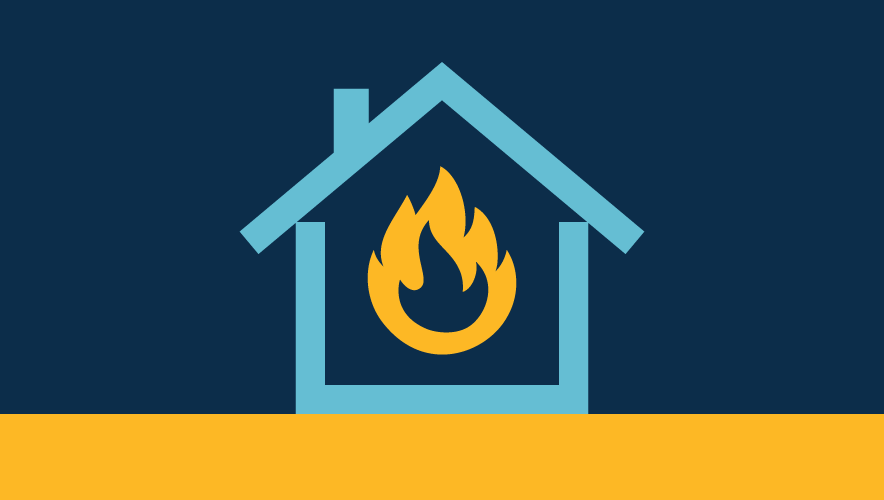How Technology Helps Multi-Housing Community Managers Work with the Fire Department to Improve Incident Response
Fires are a significant problem, devastating people and property. In just 2 minutes, a fire can become life-threatening. Within 5 minutes, an entire residential structure can be fully engulfed in flames.
Prior to implementing an automated technological solution, community managers at multi-housing communities would often hear about a fire at their property in the news or when they next reported to work.
Most multi-housing organizations cannot maintain a continuous state of alertness, especially during late or early morning hours when staff is not on duty. Fire departments cannot contact specific managers or on-call maintenance technicians that are on an on-call rotation schedule.
During fire events, vulnerable residents—the elderly and disabled—can be left to fend for themselves outside of the building until management is notified. This becomes an even more tenuous situation when there is inclement weather.
Our Solution
Opportunity Home San Antonio provides affordable housing, social services, and assistance to more than 57,000 children, adults, and seniors in San Antonio, Texas. It recently adopted an automated notification system that notifies staff about fires in real-time.
The Fire Incident Response Event (FIRE) A.L.E.R.T. (Automated Location - Emergency Response to Threats) was established by working with the San Antonio Fire Department (SAFD) and its Computer Aided Dispatch (CAD) technology.
The Opportunity Home Policy & Planning Department provides an updated list of all the multi-housing communities to the City of San Antonio (CoSA) Public Safety GIS (PSGIS) group. All of the addresses are entered by PSGIS into the CoSA CAD system.
The automated system allows staff to track incidents and gauge the effectiveness of the response.
Now, when SAFD receives a call for service to an Opportunity Home property, this triggers the notification system to alert on-call managers. These alerts are sent by SAFD to Opportunity Home via email, which are automatically converted to SMS text messages, using a gateway service, that are sent to cell phones assigned to maintenance technicians and supporting Opportunity Home departments. When certain cell phone carriers began blocking SMS text messages when they suspected them to be spam, Opportunity Home upgraded its cell phone service to an enterprise product that has a minimal cost for monthly SMS text messages so our automated services will function without interruption. Management now has a continuous state of alertness with the help of this technology.
There are 47 categories where management receives an automated alert. These include appliance fire, arson investigation, bombs, brush fires, unauthorized burns, electrical, electrocutions, explosions, extinguished fires, fire alarms, gas leaks, high-rise fires, motor vehicle collision (on property), odor of smoke, smoke investigation, structure collapse, suspicious package, vehicle fire, hazardous material, and various others. The technology allows staff to respond to any crisis immediately and contemporaneously with SAFD. An example of this in action is when there is an appliance fire that renders the unit uninhabitable, our staff is alerted and transfers the resident to a vacant unit or coordinates a temporary stay at a hotel.
SAFD responds to tens-of-thousands of calls for service, many of which are false alarms. Both SAFD and Opportunity Home saw the opportunity for improved public safety collaboration—not just for responding to actual structure fires, but also addressing fire prevention initiatives and reducing the rate of false alarms.
The most important aspect of this system is the opportunity to learn from an incident to be better prepared for future incidents.
The automated system allows staff to track incidents and gauge the effectiveness of the response towards improved detection and prioritization of actual emergencies. The operational component also allows the actual response team to go to the site of the fire in a timely manner.
The most important aspect of this system is the opportunity to learn from an incident to be better prepared for future incidents. The automated correlation facilitates various departments, previously missing from an organizational context, to allow management response teams to deploy an immediate infrastructure that supports all the logistics of response in a timely manner. Combining detection, prevention, and response reduces the time necessary to accomplish all tasks associated with a fire response, or elevator rescue, to properly follow-up and document each of the various roles and responsibilities for the various departments.
The automated technology facilitates a holistic review of our incident response processes to find the areas where we could engage in critical thought and problem-solving, and provide immediate relief for residents to minimize expenses and damage associated with fires.
The Results
In February 2023, this system was put to the test when a fire broke out in a third-floor unit of an Opportunity Home community. The fire displaced more than 70 residents. Staff was able to respond to the location in a timely manner to coordinate the transportation of 51 residents to a local hotel and helped 19 residents who opted to make arrangements to stay with family or friends. Staff worked with the American Red Cross to assist with providing clothing, toiletries, Meals on Wheels, snacks, and financial assistance. Staff also helped with the delivery of medications to each of the displaced residents.
The result of the program with SAFD was improved efficiency and effectiveness of management’s administrative operations to address immediate needs of our residents when there is a fire. Some of these needs include obtaining a clean change of clothing, coordinating relatives that residents can stay with, obtaining a hotel for those who have no local relatives, and working with the American Red Cross to provide additional support.
Staff also coordinates ready-to-eat meals and hygiene kits, including new toothbrushes, soap and washcloths. Babies need diapers and formula in addition to clothes, while the elderly may need their medications. If the family has pets, staff helps them obtain shelter and food for them.
A further success of the program is that Opportunity Home is now able to reduce the amount of overtime previously paid to staff for responding to false alarms.
When the automated fire alert is received, staff conduct an immediate “Fire Alert Triage.” Staff is directed to the SAFD Active Fire online page to monitor the call in real time. Staff also listens to the SAFD radio traffic via a telephone app to obtain updates on the status of the fire alert to verify if it is a false alarm, or an actual emergency that requires staff to deploy on-call staff. By only responding to actual emergencies, management is able to reduce overtime costs and improve the delivery of services. This correlation of details and placing context to actual emergencies allows staff to identify the alerts that constitute a real threat.
The fire alerts also help management, and our Risk Management Department, coordinate with contracted vendors to initiate the remediation process, as well as filing claims with insurance carriers.
This technology introduced a new set of organizational improvements to address challenges and incorporate automation.
Phase 1. Outline the steps to successfully respond to an incident, including incident qualification, triage, investigation, containment, notification, and post-hoc evaluation.
Phase 2. The tools and processes associated with the automation includes maintaining spreadsheets and documentsthat are shared between management and various departments. When we experience a few incidents a month, this proves very beneficial. The spreadsheets are used to track the location of each fire alert, what caused the fire, and the number of false alarms, which then allows staff to evaluate which communities need additional fire drills or fire warden training. It also helps staff plan for long-term capital improvements, such as when a fire panel needs to be repaired or replaced, as well as smoke detectors or other fire sensors.
These sheets allow staff to produce annual reports. During 2022, we received 836 fire alerts, which was evaluated with the previous year’s totals, as well as how staff responded, to help identify areas for improvement.
When a large incident, such as a structure fire occurs, staff is able to respond to the location and create an interactive document where each specific department (Management, Security, Risk Management, Finance, etc.) is able to document their activities in real-time. This helps staff conduct an after-action review of all activities, which aids our emergency management planning and protocols.
Phase 3. The automated fire alerts enhance the maturity curve, and the orchestration or administrative processes are combined with this automation. Automation helps assess the impact of a threat, as well as the impact of the environment that initiated the threat. The automation allows staff to keep track of any patterns where repeated calls for service from SAFD could lead to have what has been referred to as “false alarm fatigue.” When residents no longer have faith in a system and fail to respond appropriately to the alarm, this denigrates their confidence in the fire alarms. Staff works closely with the SAFD Fire Prevention Unit to address these types of issues by working with our staff to schedule “Safety Socials” to allow residents to ask questions and receive additional information about fire safety.
Notifying stakeholders, assigning incidents, and enriching data with context is a force multiplier that helps speed up the associated responses from each department. The actual containment of the fire rests with the SAFD, but the associated management of data frequently requires a well-coordinated effort to address fire prevention, detection, mitigation, and recovery.
Domingo Ibarra is the director of security for Opportunity Home San Antonio. He is responsible for managing, coordinating, and directing the activities of an agencywide advanced security management program. Ibarra previously served as chief of police for Magnolia, Texas, and CEO for the Police Officers Association in Corpus Christi, Texas.
© 2023 Domingo Ibarra












